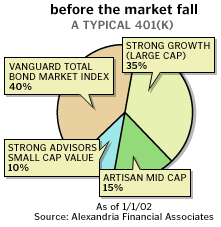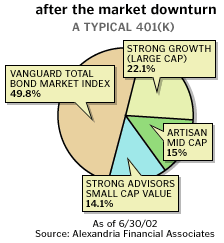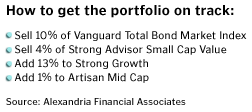NEW YORK (CNN/Money) -
In early 2001, you charted a course for your 401(k) that would withstand the test of time. The perfect blend of stocks and bonds.
Fast-forward 18 months. The equity side of your portfolio has taken a beating, while the fixed income portion is humming along with a 5 percent gain. Now, your retirement savings are hopelessly out of whack. You're left with a bond-heavy portfolio that over the years will leave your long-term investing plans adrift.
"Many 401(k) investors are frozen like deer caught in the headlights," said Tom Grzymala, a certified financial planner in Virginia. "They don't know what to do. But the first thing they need to do is check their asset allocation."
Don't be paralyzed by market losses
Indeed, studies show that 401(k) investors have become so immobilized by the bear market that they aren't doing much of anything. A July study of 800,000 401(k) investors by Chicago consultant Hewitt Associates found that only 19.5 percent of the participants made changes in 2001. That is down sharply from 2000, when 30 percent made changes.
| |
 Retirement resources
Retirement resources
| |
| | |
| | |
|
"When the market does poorly, people tend to be even less active," said Lori Lucas, a Hewitt consultant.
As a result, 401(k) investors have become bigger bond holders by default. The Hewitt 401(k) Index, which tracks the assets of 1.5 million 401(k) investors, was about 73 percent equities in early 2001. By June, the equity portion had dropped to 65 percent. Hiding out in bonds is fine if you're scared out of your wits. But long term, stocks will outperform bonds and money markets. There's simply no better way to build a retirement portfolio.
How the market zaps your asset allocation
So what do you do? Consider this hypothetical scenario derived from a 401(k) plan managed by Grzymala's firm, Alexandria Financial Associates. Let's say a 40-year-old man with a gross annual salary of $48,000 has a balance of $100,000 in his 401(k) in January 2001.

The portfolio has three stock funds with the following weightings: Strong Growth, which invests in large caps, 35 percent; Artisan Mid Cap, 15 percent; and Strong Advisor Small Cap Value, 10 percent. The rest of the portfolio, about 40 percent of the money, is in Vanguard Total Bond Market Index.
Like a good little 401(k) investor, the man faithfully socks away $200 a month, or 5 percent of his pay. He sticks with his contributions through the market trough in late September and Enron's implosion -- even staying the course in the first half of 2002, when the Dow was backpedaling towards 7,000. Grzymala's analysis assumes dividends are reinvested.

Get ready for a shock. Come June 30, the portfolio has lost a total of 10.7 percent, with a value of $92,720. And that's including monthly contributions of $3,600 and reinvested dividends of $4,133. Ouch.
Strong Growth, down 44 percent in that time, now represents just 22.1 percent of the portfolio. But the Vanguard bond fund, up nearly 12 percent, now represents 49.8 percent. Strong Advisor Small Cap Value, up 27 percent, accounts for 14.1 percent. And Artisan Mid Cap, down nearly 17 percent, is about 14 percent.
Rejiggering your mix
Here comes the hard part. To get back to the original allocation on Jan. 1, 2001, Grzymala said the hypothetical investor would need to do the following: First, sell 10 percent of the bond fund shares. Then, sell 4 percent of Strong Advisor Small Cap Value. Next, bump up the allocation in Strong Growth by 13 percent, and add 1 percent to Artisan Mid Cap.

But not everybody sticks with the same allocation. You may decide, after 18 months of a bear market, that you're not quite so bullish as you thought. There's nothing saying you can't readjust your allocation, taking into account your age, retirement goals and the number of years you have until retirement. (If you're starting from scratch or need to rethink your allocation, click here to use CNN/Money's asset allocator.)
For example, some people might decide that Strong Growth is too aggressive for their taste. The fund invests 31 percent of its portfolio in technology, and it could take longer for the sector to recover, Grzymala said. By contrast, Strong Advisor Small Cap Value has been a better performer and has only 9 percent in tech.
In that case, our hypothetical investor could add just 5 percent to Strong Growth, leaving the total weighting in large caps at 27 percent. And then, increase small-cap exposure to 18 percent. "As the economy recovers, small caps will recover faster," Grzymala said. "It's the difference between a speed boat turning around and the Queen Mary turning around."
It's hard to throw money into a black hole -- but do it anyway
Looking ahead, you may find it hard to keep shelling out $200 a month to invest in a 401(k) that keeps losing money. Don't be afraid to keep buying, even if stocks stay in a deep freeze, said Claire Bergquist, a senior 401(k) consultant at Strong Funds. The reason? Dollar-cost averaging, where you commit to investing a fixed amount every month. When the market falls, your money buys more shares. When it rises, your money buys fewer shares. Over time, your average cost is lower than if you invested all at once.
So even if the bear market continues into 2003 (which it probably won't) you won't lose as much, according to the following example from Strong. Let's say you are expecting a bonus of $400 on Jan. 1, 2003. You decide to invest in a fund selling for $50 a share. The fund loses $5 every quarter through Jan. 1, 2004. If you bought the shares all at once, you'd have a loss of $160 by 2004. But if you follow dollar-cost averaging, buying two shares every quarter, your average price per share would be $41.75 and your average loss would be just $113.
The payoff? Years from now, when the stock market recovers, all of those cheap shares you bought will be worth a lot more.

|

